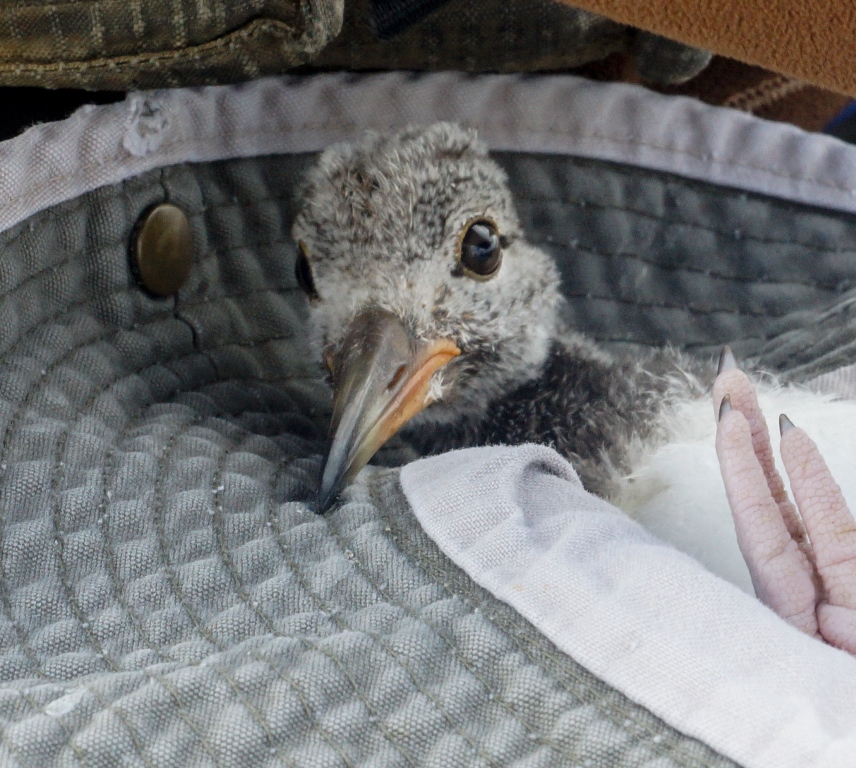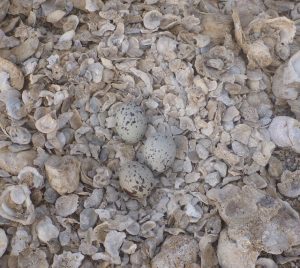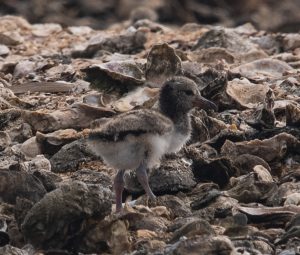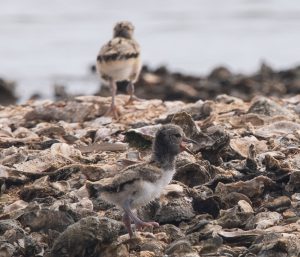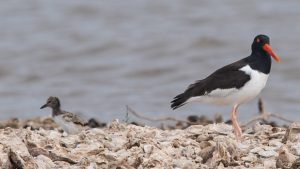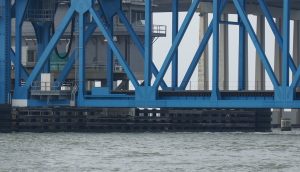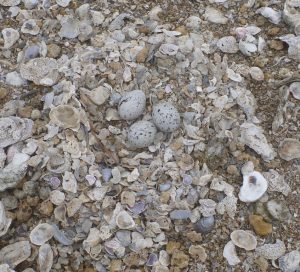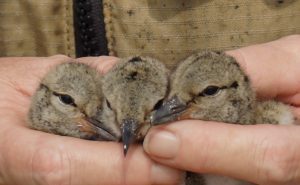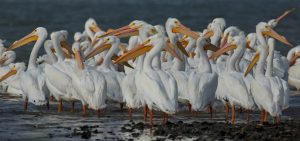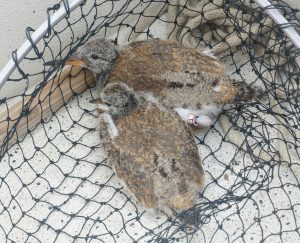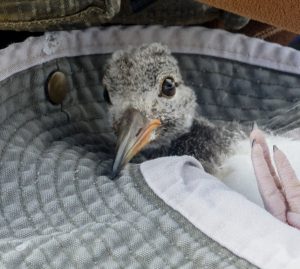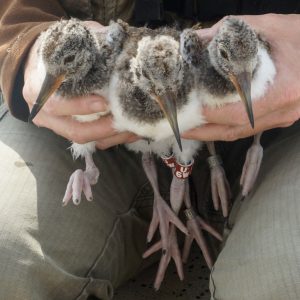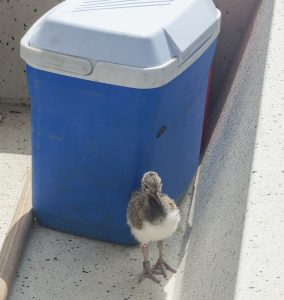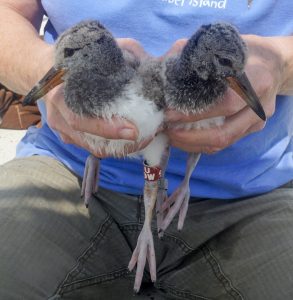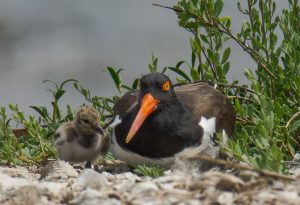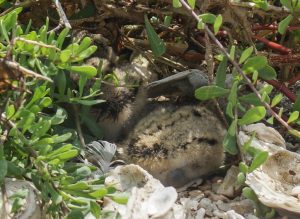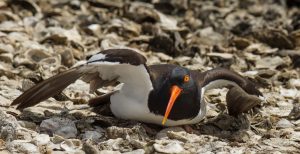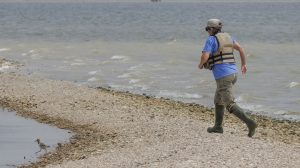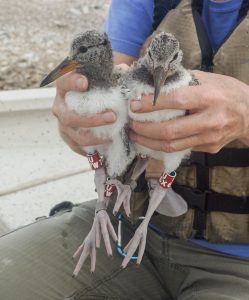By Susan Heath
On Monday, Taylor Bennett (GCBO Shorebird biologist) and Morgan Barnes (GCBO intern) went with me to East Matagorda Bay. They closed the beaches in Matagorda County so we thought we might have to use an alternate boat ramp because the one we normally use is on the beach road. Fortunately we could still get to it so we headed out with no problem.
We found EF & M4 on a small island along the GIWW near Chinquapin so their nest on Dressing Point clearly failed. I didn’t think it had much of a chance because there are so many other birds nesting there but it’s still a bummer. A little farther down the GIWW, we found A7A on a reef. He flew out calling and making a big fuss which to me meant his mate was on a nest. Sure enough when we got out to his nesting island, we found her incubating three eggs.
Even though we knew EF & M4 had failed, we headed out to Dressing Point anyway. The area where their nest had been was covered by Brown Pelicans so it’s a sure bet that they are the culprits. Poor oystercatchers.
We headed over to the Oyster Farm and I was quite pleased to see that LF & unbanded had returned to their territory. They didn’t have a nest but hopefully soon. I was even more pleased to discover that the Great Blue Herons do not appear to be nesting again on the other island there. Maybe the oystercatchers that previously nested on that island will return now that the herons are gone.
We motored all the way to the west end of the bay to see if LC & R9 had a nest but they were not home. Things got a little more exciting when we got to Old Gulf Cut. We didn’t see 25 & unbanded on their island so I was afraid their nest had failed but just as we approached, one of them flew in with food and I saw two chicks fighting over it. There was a third running for cover. Three chicks! The adult started calling, the chicks ran for cover, and the other adult flew in for reinforcement. We backed off quickly and they settled down. These chicks are on a very low island so it will take another 35 days without an above normal high tide for them to fledge. Cross your fingers.
The other pair at Old Gulf Cut, C7A & unbanded were still incubating three eggs so we headed back down the GIWW towards the boat ramp. There was one more pair to check. ER & unbanded only had one egg last week so I needed to see if they had increased that number. We found one of them incubating which was good news. At least the nest was still there. We had a little trouble getting the boat up to where the nest is because of the wind, but we finally managed it. I verified they now have three eggs. Yeah! You go ER & unbanded.
I was feeling really good about those chicks at Old Gulf Cut on Monday night when my phone beeped with yet another COVID19 update. It said Galveston County was issuing a stay at home order effective Tuesday night at 11:59pm. Oh no! I had expected Harris County to be first and so I’d have a little warning but nope, it didn’t happen that way. I called Alan and we made arrangements to go out on Tuesday rather than Wednesday so we could check the birds one more time.
The weather forecast for Wednesday had looked delightful. Sadly Tuesday was a bit windy but at least it was warm. The wind was supposed to get worse as the day went one so we decided we’d better head up to Swan Lake first thing. The railroad bridge had other ideas though as it was down.
Since the tide was too high for us to go under it, we went to Jigsaw to see what those pairs were doing. They were both there and acting a bit suspicious but we did not find any nests. When we were done there, the bridge was just going up so we headed towards Swan Lake.
We hadn’t seen C2A & E0A on their island along the Tiki Channel in quite a while so we went to see if they were on their favorite dock just north of the I-45 bridge. They weren’t there though. We headed up along the breakwater that runs along the shoreline and lo and behold, Alan spotted them on a small shell bar and one of them appeared to be on a nest! It was a lovely one too if I do say so myself. The shells were arranged just so with three eggs.
This spot isn’t any better than their other spot but it does have the advantage of places to shelter chicks in a high tide. Since we haven’t been by here in a long time, we don’t know how long it’s been there. I’d love to see how this turns out.
The other pairs along the Scenic Galveston shoreline had nothing going on so we entered Swan Lake. K7 & unbanded have been acting sketchy for weeks but we’ve always been up there at the end of the day when time was too short to investigate much. This time I followed along the breakwater to where we could see a new shell patch that was deposited over the winter instead of going to where they’ve nested in the past. Sure enough I saw an orange bill in the vegetation. If they didn’t have that bill they’d be much harder to find! I expected we’d find a nest and I had already hopped off the boat to go look when I saw instead three newly hatched chicks! Wow! They really snuck that one by us. I don’t usually pick up chicks but they were threatening to separate and run and I was thinking we’d not be up there again for a while because of the stay at home order so I just grabbed them. Alan snapped this photo.
I found a place to set them in the vegetation where they’d feel safe and give us time to get the heck out of there. Of course K7 & unbanded were not at all happy with us and I suspect they were more upset that we discovered their secret than that we would harm the chicks. They are VERY good at hiding their chicks so when it comes time to band those little ones, we’ll be lucky if we can find them again.
On that high note, we went to check on the other pairs. 39 & unbanded were still incubating two eggs. Why only two you guys? You can do better than that! X3 & unbanded’s territory was awash in white pelicans but we discovered they had a two egg nest anyway. Hopefully the pelicans won’t crush the eggs with those big feet. We headed back to West Galveston Bay.
I’d been debating with myself ever since I heard about the stay at home order whether I should band the chicks in West Galveston Bay. There are two sets of them (12 & unbanded and LT & JA) on Struve Luci and Fred’s on Marker 52. Next week would be the optimal time to band them but I didn’t know if we’d be able to get out there next week. I don’t like to band them until right before they are going to fledge because after we’ve handled them, they are more subject to disturbance and will swim away from the island if a fisherman or boater gets too close. I finally decided that if we couldn’t get out there, other boats wouldn’t be out there either so there wasn’t much chance of disturbance. So we went to band them.
The nice part about banding them when they are younger is that they are much more apt to hide than run when you go to catch them. We thought 12 & unbanded had two chicks but after a thorough search we found three chicks hunkered down on the reef trying to blend in. They did a good job of it too. I wish I’d taken a photo. We gathered them up and took them back to the boat. One of them was a lot smaller than the other two so we didn’t band it. We got the other two done quickly and then let them all go at the same time.
Then we checked on HM & X7’s nest on the rock jetty. One of them was incubating but there was only one egg in the nest. I was wondering why a predator would take only two eggs when it occurred to me that the others might have hatched and the predator took the chicks. We looked from the boat but didn’t see any chicks hiding. It’s possible we missed them though. Those rocks are good at hiding things.
L9 & unbanded were still incubating their nest so we went to gather up LT & JA’s chicks. We had seen three previously but today we could only find two. They weren’t as big as I would have expected them to be if there were only two of them so I expect there was another one hiding somewhere. This little guy decided to take a tour of the boat while I was banding his/her sibling.
I put them back where we found them and they both lay down in the vegetation so all was well. The Black Skimmers are beginning to return here to nest. It is heartening to me that the birds are still doing their thing right on schedule even though the human world is in such turmoil. Take heart. We’ll get through this!
We headed down to Gangs Bayou and found A1A & unbanded on the breakwater, though they weren’t together. Perhaps they are having a spat about something. A4A & unbanded were down on the end of the island and one of them was laying up on the shell bank looking for all the world like it was on a nest but there were no eggs when I investigated. Fooled again by the crafty oystercatchers.
On South Deer all was well. A5A & unbanded were incubating their nest as was 16 & unbanded. It looks like F1A & E2A have chosen HL’s old territory over KK’s but they didn’t have a nest. One surprise was that Y7 & unbanded were back. Now where the heck have you been all this time? That’s the only pair from last year that remains on this island. I’m still perplexed as to what happened to the rest of them.
We continued on to North Deer where after much finagling we were able to get to a spot where I could go and see if E6A & unbanded had a nest. We thought they did last week but the wind was blowing straight in there and I was afraid we wouldn’t be able to get the boat back out once we got in. Today we tried a different tack and it worked out ok. And yes our suspicions were correct. E6A & unbanded have a three egg nest! Sadly C1A & unbanded’s remaining egg was gone. Bad pelicans! YM & JH were still incubating so we let them be and went to check on J6 & UF. I had been looking forward to this all day because it was time for their nest to be hatched.
When we got there, one of them was sitting up where the nest had been and I was briefly disappointed but it turned out it was brooding three newly hatched chicks! Way to go J6 & UF. We’ve been watching them for years and this is the first time they managed to have chicks. I tell them every year to lay their eggs early and this year they finally listened! That’s my story anyway. J6 & UF were most upset at our intrusion and one of them started doing a broken wing display. Wilson’s Plovers do this all the time but I’ve never seen an oystercatcher do it. Sorry J6 & UF! We will leave you to your chicks and best of luck. It will take 35 more days without a higher than normal tide before those little guys can fledge.
JJ & P4 were along the water’s edge on Marker 52 and didn’t appear to have a nest. JC was incubating her nest while W5 stood watch nearby. We went to check on CA & Y2 before tackling FR(ed) & unbanded’s chicks. CA & Y2 had a one egg nest! The Caspian Terns have also started to lay eggs there so we’ll have to be careful not to disturb them when checking on the oystercatchers.
Fred had been ominously absent as we passed his territory on our way to check CA & Y2 and I feared that was a bad sign but when we headed straight for his island he came out to escort us so all was well. I went to search for the chicks while Alan was anchoring the boat. Suddenly I heard Alan yelling. Uh oh. We’ve got a runner! One of the chicks was running down the island. Dang it! I didn’t bring the dip net with me because all the other chicks had stayed in hiding. I ran after it and was able to grab it just as it jumped in the water and dove. Phew
Alan found the other chick hiding nicely in a tangled mess of tree branches. These guys were larger than LT & JA’s which convinced me even more that LT & JA had another chick hiding somewhere. Sneakers.
We had to keep a close check on the chick that was the runner. It was having none of our nonsense! We got them both banded though and I tried to put them back where the one had been hiding. That one lay down nicely but the other one started running again. This is a long island so it had plenty of room to run. I ran the other way back to boat so that it would hopefully stop its retreat when it realized the danger was gone. One of the adults flew over to where it was running so all was well. Leave it to Fred to have the only chick that was a runner the whole day. Fred junior I suppose.
The last pair was X4 & unbanded. They were on separate reefs feeding but one of them flew to the island and walked up the shell berm so I thought maybe they had an egg. Just a scrape though. And so the day came to an end. It was a great day and I was very happy we were able to get out there and check on all the pairs.
I watch the news every night and KHOU11 has a segment where they verify things for people. Someone had asked if boating and fishing were allowed during the stay at home order. The answer was yes and I immediately sent them an email and asked if you could trailer a boat to a boat ramp. The answer to that was yes also. The next morning our Executive Director, Martin Hagne, talked to two sheriff’s deputies who also said it was ok to trailer a boat to a boat ramp. So perhaps we don’t have to stop checking the birds? There are a lot of things to think about with that. We don’t want to get or spread the virus.
GCBO had to cancel all spring events including our biggest fundraiser of the year Brew on the Bayou. We also can’t access several of our field sites on the beach which means we can’t charge our time to the grant paying for that work and will have to use our limited general funds to cover salaries. Donations are likely to be quite low in the future since so many people are struggling financially. If you can spare some change, we’d appreciate any help you can provide us. There are tough times ahead. You can make a donation (thank you!) on our website here or adopt a pair of oystercatchers here.
Current Stats for upper Texas coast from Dickinson Bay to East Matagorda Bay: 15 nests being incubated, 4 failed nests, 5 nests with unfledged chicks, 0 nests with undetermined status, 0 chicks fledged
Note: All trapping and banding for this project is in accordance with federal and state permits issued to Susan Heath, GCBO Director of Conservation Research. Bird handling by volunteers is only permitted in the presence of Susan Heath and volunteers are trained in proper bird handling techni

